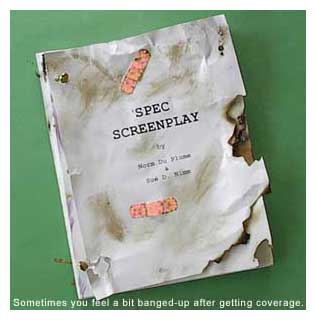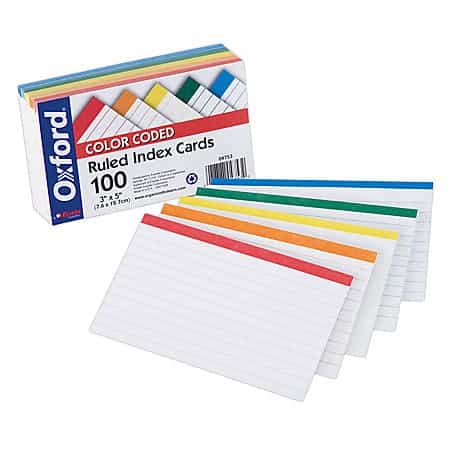You’ve just received your script analysis back from us. There’s probably some good news and some bad. But more than anything, there’s work to be done. Before you strangle the cat, read this handy Survival Guide!
By Jim Cirile
Let’s be honest: nobody wants to hear criticism.
You’ve labored for months, maybe years on a script, and now some dope is picking it to pieces. All any of us really want to hear when we send in a script for coverage is, “It’s great! Don’t change a word!” When that doesn’t happen, well, it’s enough to depress even the most steely of us.
“This reader is a &^#*&@)!!! idiot.” How many times have I said this? Hundreds — as recently as a few months ago, when I sent one of my scripts (under a pseudonym) into one of our readers for analysis. How could this guy, who’s given such smart feedback on everyone else’s scripts, be so wrong about mine? Jeez!
 Then a very strange thing happened when I went over the notes with my writing partner. After I griped vociferously about several of the notes just being completely off the mark, we agreed that okay, there were a few good ones, too. So we dug in and fixed those. We wound up making a lot of fixes based on the “good” suggestions. But there was still a LOT of bad notes in there, stuff completely wrong for our script. And that’s when my partner proffered, “I dunno, man. Maybe he has a point.”
Then a very strange thing happened when I went over the notes with my writing partner. After I griped vociferously about several of the notes just being completely off the mark, we agreed that okay, there were a few good ones, too. So we dug in and fixed those. We wound up making a lot of fixes based on the “good” suggestions. But there was still a LOT of bad notes in there, stuff completely wrong for our script. And that’s when my partner proffered, “I dunno, man. Maybe he has a point.”
Whoa. Bolt from the blue. My partner thought the stinky, egregious notes had validity? Dripping with annoyance, we dissected that offending section of script. Okay, maybe there was something amiss. But following the reader’s suggestions would mean adding maybe ten pages to a script that was too long already.
It was then that we realized a key fundamental flaw in our structure — a huge plot hole we’d never spotted before. The reader missed it, too — BUT the changes he suggested were his attempt to solve a problem he couldn’t quite put his finger on. With the angels in heaven now cranked up to 11, my partner and I devised a solution to this plot hole that took up exactly one-half page of screen time (and allowed us to cut some clunky exposition later.) Three weeks later, after over a year of getting “consider with reservations” on the script, the next round of coverage we got a “strong consider,” and now that very script is out to a dozen companies and is getting very good feedback.
I now view that very same idiot reader as a $%&*#@*&^!!! genius.
Next time out? I’ll probably spit and cuss and call him a frigging moron all over again. I never learn.
So now you’ve just gotten a coverage report, or analysis, as we like to call it, back from CI. You open it with trepidation, hoping those first couple of sentences will be positive. And then your eyes start to glaze over as you realize — oh, my goodness, the coverage is asking me to do a lot of work.
Deep breath. How do we deal with this? There are several possible ways. Here’s what I do: avoid it.
Seriously. I always, without fail, briefly skim the analysis. I do not read it in depth. I collect the overall impressions, the major areas pro and con. And then I put the darn thing aside.
For days.
Why? Well, human nature is a very interesting thing. In my case, my gut reaction is always: I don’t want to deal with this right now. Same thing with e-mail, right? When you get an e-mail from someone that you know is going to require a chunk of your time or your full attention, or deals with an uncomfortable subject — if you’re like me, you’ll save that mail for a few days, let it ferment a bit before you finally deal with it. Well, I’ve found this technique works great with script analysis, too!

The break does several things. First, it allows a bit of genuine curiosity to build up, to overcome the knee-jerk “get it away” response from the initial perusal. Secondly, it allows GUILT to build up, too! Yep, I paid for that coverage. My script’s just sitting there getting moldy. I’ve run out of things to procrastinate with. Sigh. Might as well crack my knuckles and dig in. Lastly, since I’d already perused the coverage, that time helps me accept the bad news and be able to handle it, so when I really do dig into the notes after a several day break, it doesn’t feel like I’m getting my guts chopped out with a rusty claw hammer.
And then I’ll print it out and read the coverage top to bottom about ten times. I want to get to know every word of it, make sure I understand where the reader’s coming from. With a red pen, I will check every note or comment I like and cross out anything I don’t.
At this point there’s probably something like 20 things to be fixed ranging from tiny to spine-ripping. The thought of taking on a massive rewrite like that is enough to send any writer running home to mama. I’ve found the best way to tackle it is to draw up an action plan.
My action plan is simply a to-do list. I open up my word processor and write each note the reader mentioned. Then if I have an idea for a fix, I’ll write it in. If not, I’ll leave it blank and get back to it. By the end, I’ll have my 20 notes and maybe 10 fixes (with another 10 to be determined later.) I will again print this out, and then… I will do what every writer in the world does.
I do the tiniest notes first.
Yep, that typo on page 93? Got that sucker! One down! Only 19 to go. Solving the easiest problems first gives you a huge psychological leg up. Let’s say after two hours of working on script changes, you’ve managed to knock that forbidding 20-item list down to 14 items. Heck, 14 items? That’s almost manageable! Plus doing the small stuff first allows you to ease back into the world of the script again, get back in the groove.
 But eventually I have to deal with note number 8 (or whatever): Act 2 simply doesn’t work. Uh oh. Yikes. A bit harder to fix than note #17, the misnamed character on page 5. This is where things get critical. Do not lose that momentum you gained from plunging into those easy fixes! Stay focused and confident. You CAN do it!
But eventually I have to deal with note number 8 (or whatever): Act 2 simply doesn’t work. Uh oh. Yikes. A bit harder to fix than note #17, the misnamed character on page 5. This is where things get critical. Do not lose that momentum you gained from plunging into those easy fixes! Stay focused and confident. You CAN do it!
One of the hardest things about dealing with coverage is when the note says a big chunk of script needs to go away and/or be completely rethought. All that work-for nothing??? As writers, we must learn “how to kill our children.” Because from their ashes, a new, stouter oak may sprout, to mix metaphors rather unappetizingly. So fear not — just break out the ol’ index cards (OK, for those of you not as old school as me, you can use your Save the Cat! structure software or even the index card tool in Final Draft. Me? I like actual paper.)
Everybody knows about index cards, but I’m always surprised by how few writers actually use them. Index cards are your very, very best friend. They allow you to shuffle scenes around easily, add new ones or delete existing ones. With help from index cards and some colored markers (or even — gasp — COLORED index cards,) you WILL be able to tackle that big section that needs revising. Here’s how.
First, card out the sequence as it exists in the current draft. Every scene gets its own card: location, character, 1-sentence description of plot events. For extra credit, assign everyone in the script a COLOR. I color my character names on every card. By doing this, I can tell at a glance if there’s too much of one character in a long sequence or act, and not enough of another. Is your bad guy in there enough? Well, if you’ve assigned dark blue to your baddie, and there’s no dark blue in the entire 30-page sequence you just carded out, guess what? You probably need a new bad guy scene in there.
Once that’s done, I go back through the action plan and look at the changes suggested by the reader and any ideas of my own. What has to go? What can we keep? Pull out any cards of scenes that are getting the axe. Replace any in which the scene content has changed. What are you left with? Do those scenes now flow well, or do they need some new connective tissue? Does Plot Event A lead us directly to Plot Event B? Are we following our protagonist and not getting side-tracked with subplots? If not, can we juggle the order so things work better, or add a new scene or new dialogue to an existing scene, to facilitate that? Playing around with the puzzle pieces is actually pretty fun, and the best part is, it doesn’t seem like you’re really working on your script! Heck, you’re screwing around with cards and markers and stuff. It’s friggin’ arts & crafts!
Amazingly, in an hour or so you will most likely have a solid idea of how to rework that huge sequence, and best of all, you might even be able to save a bit of what you had before. Which means LESS WORK for you!
Once you’ve done this, you’re well on your way towards making that script rock!
 There are a few other issues with dealing with coverage that we all stumble over. What if you just can’t think of a good solution to a story problem? Well, don’t forget that CI is just an e-mail away. We are happy to forward your follow-up questions to the reader at no additional charge (follow-ups are free as long as they take the reader ten minutes or less.) Writers frequently bounce ideas off us for feedback. We love that!
There are a few other issues with dealing with coverage that we all stumble over. What if you just can’t think of a good solution to a story problem? Well, don’t forget that CI is just an e-mail away. We are happy to forward your follow-up questions to the reader at no additional charge (follow-ups are free as long as they take the reader ten minutes or less.) Writers frequently bounce ideas off us for feedback. We love that!
And if you’re really stuck, or just want to have a long chat about different directions you can go or anything else related to the script, you can set up a phone conference with us. Just contact us and we’ll make it happen.
The last tough problem is, what if the script simply has little commercial potential or an insurmountable flaw? We call ‘em like we see ‘em, and sometimes even the best-executed version of a certain script might be a dead-end. For example, maybe your script’s central premise is just too similar to another movie, thus severely limiting your chances of setting the project up. Or maybe your intergalactic space war movie starring giant robot asparagus philosophers is just way too expensive to make and appeals to no known market segment.
This is a tricky situation to be in. You have to make a choice — continue working on the script, or shelve it and start a new one? No writer likes to shelve anything, but I can tell you that I have over 40 scripts collecting dust on my shelf, most of which are simply not sellable. It’s hard, but you have to be able to move on. That’s why it is ALWAYS a good idea to have another idea in the hopper, something else to work on. Remember, with each script, your writing skills will grow. Sure, you may be able to rewrite the robot asparagus philosopher script to address some of the problems, but is doing that really worth your time versus starting something new? That’s up to you to decide, but I can tell you that I know a writer who spent ten years rewriting her one and only script. She’s still at it. Hmm…
 I hope my own experiences and tips help you guys in coping with your own script coverage experience. Most importantly, push yourself to embrace the tough notes as well as the easy ones, for it is in the tough ones that real growth will come as a writer. And remember: Coverage, Ink is here to help. Don’t be afraid to contact us.
I hope my own experiences and tips help you guys in coping with your own script coverage experience. Most importantly, push yourself to embrace the tough notes as well as the easy ones, for it is in the tough ones that real growth will come as a writer. And remember: Coverage, Ink is here to help. Don’t be afraid to contact us.
Just remember: you rock! Now stop procrastinatin’ and get writin’!


